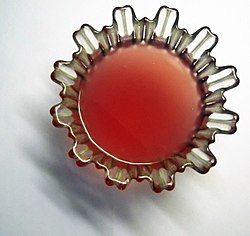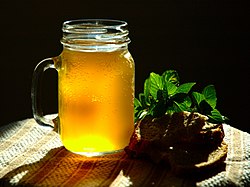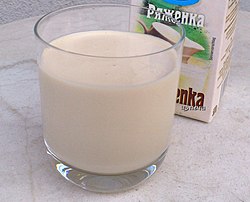Russian dishes
Zakuski (Appetizers)
| Name | Image | Description |
|---|---|---|
| Caviar |  | Known as ikra. Processed, salted roe, often of sturgeon [3] |
| Courgette caviar |  | Cold entrée made of stewed vegetables (predominantly courgettes). Usually it is eaten with bread [4] |
| Julienne |  | Мushrooms in cream or béchamel sauce topped with grated cheese and baked in a cocotte. Chicken, fish or seafood can also be used with or instead of mushrooms. |
| Kholodets |  | An aspic that is also known as studen [5] [6] |
| Salo |  | A dish consisting of cured slabs of fatback with or without skin |
| Stroganina |  | A dish of the indigenous people of northern Arctic Siberia consisting of raw, thin, long-sliced frozen fish. |
| Zakuski |  | Refers to a variety of hors d'oeuvres, snacks, appetizers, usually served buffet style. [7] It often includes cold cuts, cured fishes, mixed salads, kholodets, various pickled vegetables and mushrooms, pirozhki, caviar, deviled eggs, open sandwiches, canapés and breads. [7] |
Soups
| Name | Image | Description |
|---|---|---|
| Okroshka |  | Cold soup of mostly raw vegetables like cucumbers, spring onions, boiled potatoes, with eggs, and a cooked meat such as beef, veal, sausages, or ham with kvass, topped with sour cream [8] |
| Rassolnik |  | A soup made from pickled cucumbers, pearl barley, and pork or beef kidneys [9] |
| Shchi |  | A cabbage soup. [10] Also can be based on sauerkraut. [10] Kislye Shchi (sour shchi) despite its name is a fizzy beverage similar to kvass, usually with honey.[ citation needed ] |
| Borscht | 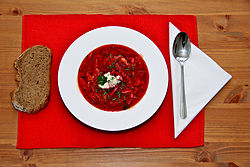 | It is traditionally made from meat or bone stock, sautéed vegetables, and beet sour (i.e., fermented beetroot juice). Depending on the recipe, some of these components may be omitted or substituted. |
| Svekolnik | 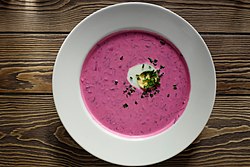 | Cold borscht involves use of dairy products and halves of boiled eggs. |
| Solyanka | 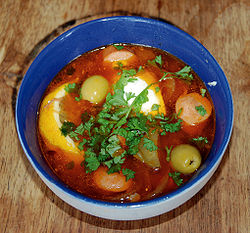 | A thick, spicy and sour soup that contains meat and pickled cucumbers [11] |
| Fish Solyanka |  | Variation of solyanka replacing meat with fish. |
| Shchavel soup (green shchi) |  | Water or broth, sorrel leaves, salt, sometimes with whole eggs or egg yolks, potatoes, carrots, parsley root, and rice [12] [13] |
| Ukha |  | A clear soup, made from various types of fish [14] |
Salads
| Name | Image | Description |
|---|---|---|
| Dressed herring (Seld pod shuboi) |  | Diced, salted herring covered with layers of grated, boiled vegetables (potatoes, carrots, beet roots), chopped onions, and mayonnaise [15] [5] |
| Mimosa salad |  | A festive salad, whose main ingredients are cheese, eggs, canned fish, onion, and mayonnaise[ citation needed ] |
| Olivier salad (Stolichniy salad) |  | Diced potatoes, eggs, chicken or bologna, sweet peas, and pickles with a mayonnaise dressing. Other vegetables, such as carrot or fresh cucumbers, can be added. [16] [5] |
| Vinegret |  | Diced boiled vegetables (beet roots, potatoes, carrots), chopped onions, and sauerkraut and/or pickled cucumbers. [17] [18] [19] Other ingredients, such as green peas or beans, are sometimes also added. [18] [19] Dressed with vinaigrette, mayonnaise or simply with sunflower or other vegetable oil. |
Meat dishes
| Name | Image | Description |
|---|---|---|
| Beef Stroganov |  | Pieces of sautéed beef in sauce, with smetana (sour cream) [20] |
| Chicken Kiev |  | A dish made of chicken fillet pounded and rolled around cold butter, then coated with eggs and bread crumbs, and either fried or baked. |
| Golubtsy |  | Cooked cabbage leaves wrapped around a variety of fillings [21] [5] |
| Makarony po-flotski |  | Literally navy-style pasta, a dish made of cooked pasta (typically macaroni, penne or fusilli) mixed with stewed ground meat, fried onions and seasoned with salt and black pepper. |
| Pelmeni |  | Dumplings consisting of a meat filling wrapped in thin, pasta dough [22] [23] [5] |
| Pozharsky cutlet |  | A breaded ground chicken patty [24] |
| Shashlyk |  | A dish of skewered and grilled cubes of meat. |
| Veal Orlov |  | A dish invented by the French [25] consisting of braised loin of veal, thinly sliced, filled with a thin layer of pureed mushrooms and onions between each slice, topped with bechamel sauce and cheese. Various versions of this dish usually go by the name French-style meat in Russia today. |
Pancakes
| Name | Image | Description |
|---|---|---|
| Blini |  | Pancakes of various thickness and ingredients. [26] [5] Also known as blinchiki. |
| Oladyi |  | Small thick pancakes [27] |
| Syrniki (tvorozhniki) |  | Fried pancakes made of tvorog, usually topped with sour cream, varenye, jam, honey, or apple sauce [28] [29] |
Bread
| Name | Image | Description |
|---|---|---|
| Baranka |  | A dough ring somewhat smaller than a bublik, but also thinner and drier |
| Borodinsky bread | 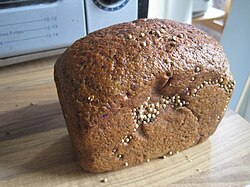 | Dark brown sourdough rye bread |
| Bublik |  | A ring of yeast-leavened wheat dough, that has been boiled in water for a short time before baking |
| Karavai |  | A large round braided bread, traditionally baked from wheat flour and decorated with symbolic flags and figurines, such as suns, moons, birds, animals, and pine cones. |
| Kalach |  | Historically, kalach meant any kind of white bread, and before modern methods of grinding wheat came into use, white bread was classed as a type of fancy bread. |
| Kulich |  | One of the two sine qua non attributes of the Russian Easter (the other is Paskha). [30] A type of Easter bread. [30] |
| Sushki |  | Traditional small, crunchy, mildly sweet bread rings eaten for dessert, usually with tea or coffee |
Pirogi (pies)
| Name | Image | Description |
|---|---|---|
| Kulyebyaka |  | A fish (usually salmon or sturgeon) loaf, with rice, hard-boiled eggs, mushrooms, and dill [31] |
| Karelsky pirog |  | A traditional pirog from the region of Karelia. |
| Kurnik | 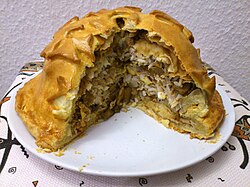 | A dome-shaped savoury type of Russian pirog, usually filled with chicken or turkey, eggs, onions, kasha or rice, and other optional components. [32] [33] |
| Rasstegai |  | The filling usually contains fish, but may also contain meat, liver, rice or mushrooms. |
| Pirog |  | A pie either with a sweet or savoury filling [34] |
| Pirozhki |  | Small pies [35] [5] |
| Vatrushka |  | A pastry with a ring of dough and sweet tvorog in the middle [36] |
Kasha (porridge)
| Name | Image | Description |
|---|---|---|
| Kasha |  | Porridge. Buckwheat, [37] millet, oat and wheat kashas are widely popular in Russia. [38] [5] |
| Gorokhovaya kasha | 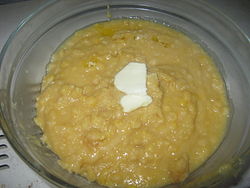 | Pease porridge, similar to British pease pudding. |
| Guriev porridge |  | A Russian porridge dish prepared from semolina and milk with the addition of nuts (hazelnut, walnuts, almonds), kaimak (creamy foams) and dried fruits. [39] |
| Kutia |  | A ceremonial grain dish with sweet gravy. |
| Mannaya kasha |  | Semolina porridge, similar to the Guriev one. |
| Perlovka (Pearl barley kasha) |  | Pearl barley porridge. |
Sauces
| Name | Image | Description |
|---|---|---|
| Khren |  | A spicy paste made of grated horseradish. |
| Khrenovina |  | A spicy horseradish sauce served with a main course, which is very popular in Siberia. |
| Smetana |  | A dairy product produced by souring heavy cream. |
Desserts
| Name | Image | Description |
|---|---|---|
| Russian-style Charlotte |  | crunchy on the outside and soft inside pie with apples |
| Medovik |  | The identifying ingredients are honey and smetana (sour cream) or condensed milk. |
| Russian-style Napoleon cake |  | A dessert made of puff pastry layered with pastry cream. |
| Paskha | 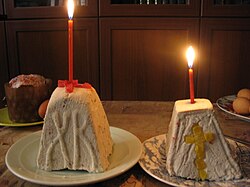 | Tvorog (farmer's cheese) plus heavy cream, butter, sugar, vanilla, etc., usually molded in the form of a truncated pyramid. Traditional for Easter. |
| Pryanik |  | A range of traditional sweet baked goods made from flour and honey. |
| Pastila |  | It has been described as "small squares of pressed fruit paste" and "light, airy puffs with a delicate apple flavor". |
| Syrok | 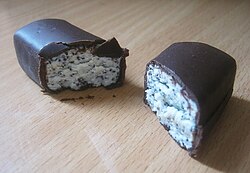 | A type of sweet dairy food made from glazed or unglazed curd cheese with or without filling. |
| Khvorost |  | A traditional sweet crisp pastry made out of dough that has been shaped into thin twisted ribbons, deep-fried and sprinkled with powdered sugar |
| Pyshka (or Ponchik) |  | A Russian variety of doughnut. |
| Varenye |  | It is made by cooking berries, other fruits, or more rarely nuts, vegetables, or flowers, in sugar syrup. |
| Zefir |  | A type of soft confectionery made by whipping fruit and berry purée (mostly apple puree) with sugar and egg whites with subsequent addition of a gelling agent like pectin, carrageenan, agar, or gelatine. |
